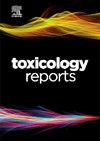Assessment of heavy metal exposure and cancer risk in Addis Ababa: Trends, risk factors and demographic variations in urinary cadmium, lead and chromium levels
Q1 Environmental Science
引用次数: 0
Abstract
This study aims to assess the exposure levels of Pb, Cd, and Cr and evaluate trends in heavy metal exposure among the population of Addis Ababa. A cross-sectional study was conducted involving 417 participants randomly selected from the population. Spot urine and water samples, socio-demographic characteristics, and food consumption frequency were collected. Heavy metals were analyzed using microwave plasma-atomic emission spectroscopy. Metal exposure risk from drinking water was assessed. The median concentrations of urinary Pb, Cr, and Cd were 19.4865 µg/g creatinine, 55.65 µg/g creatinine, and below the detection limit (Bd), respectively. Female participants and individuals who consumed meat daily had the highest median concentration of Pb (p < 0.005). Those who drank two or more cups of water daily had lower Pb (P < 0.01). Females who consumed eggs daily and drank two or more cups of water had the highest concentration of Cd, ranking in the 75th percentile. The median Cr concentration was higher in underweight participants (BMI < 18.5 kg/m²) at 88.41 µg/g creatinine and in overweight participants (BMI ≥ 25 kg/m²) at 66.49 µg/g creatinine compared to normal-weight participants, who had a median concentration of 48.44 µg/g creatinine (P < 0.01). Three metals were detected in 14.4 % and two metals in 52.8 %, and their levels showed an increasing trend over 12 years. Health risk analysis revealed that the highest Cumulative Incremental Life Cancer Risk (CILCR) values were found in Kirkos (KR-10–1.9 ×10−3), Lideta (LI-10–2.33 ×10−3), and Nifas Silk (NS-11–2.46 ×10−3) districts, indicating a significant cancer risk associated with cumulative exposure.
亚的斯亚贝巴重金属接触和癌症风险评估:尿中镉、铅和铬水平的趋势、风险因素和人口变化
本研究旨在评估亚的斯亚贝巴人口中铅、镉和铬的暴露水平,并评估重金属暴露的趋势。一项横断面研究从人群中随机选择了417名参与者。收集尿样和水样、社会人口统计学特征和食物消费频率。采用微波等离子体原子发射光谱对重金属进行了分析。对饮用水中的金属暴露风险进行了评估。尿Pb、Cr、Cd中位浓度分别为19.4865 µg/g肌酐、55.65 µg/g肌酐,均低于检出限(Bd)。女性参与者和每天吃肉的个体的铅中位数浓度最高(p <; 0.005)。每天喝两杯或两杯以上水的人铅含量较低(P <; 0.01)。每天吃鸡蛋并喝两杯或两杯以上水的女性Cd浓度最高,排名在第75个百分位数。与正常体重的参与者相比,体重不足的参与者(BMI < 18.5 kg/m²)的Cr浓度中位数为88.41 µg/g肌酐,超重参与者(BMI≥25 kg/m²)的Cr浓度中位数为66.49 µg/g肌酐,正常体重的参与者的Cr浓度中位数为48.44 µg/g肌酐(P <; 0.01)。3种金属含量为14.4% %,2种金属含量为52.8% %,在12年内呈上升趋势。健康风险分析显示,Kirkos (KR-10-1.9 ×10−3)、Lideta (LI-10-2.33 ×10−3)和Nifas Silk (NS-11-2.46 ×10−3)地区的累积累积终身癌症风险(CILCR)值最高,表明累积暴露与显著的癌症风险相关。
本文章由计算机程序翻译,如有差异,请以英文原文为准。
求助全文
约1分钟内获得全文
求助全文
来源期刊

Toxicology Reports
Environmental Science-Health, Toxicology and Mutagenesis
CiteScore
7.60
自引率
0.00%
发文量
228
审稿时长
11 weeks
 求助内容:
求助内容: 应助结果提醒方式:
应助结果提醒方式:


